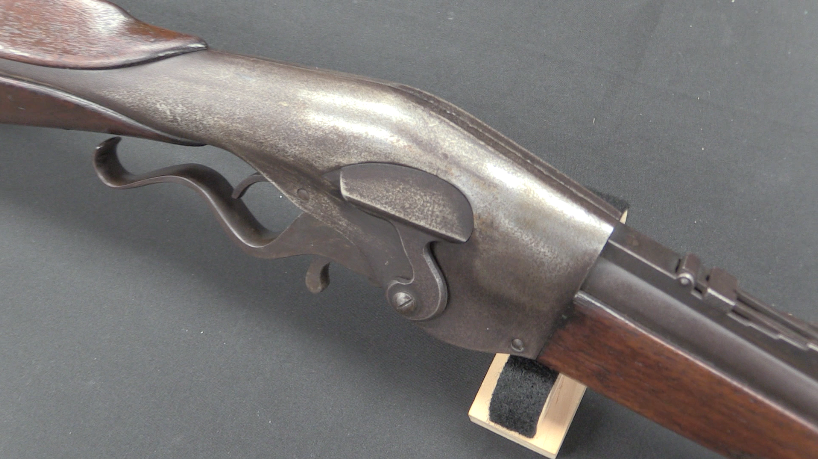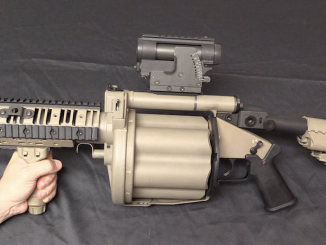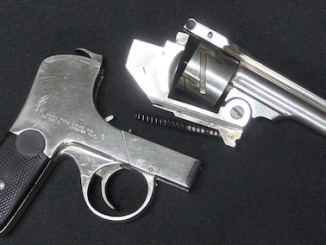The US National Firearms Act includes a category called “Any Other Weapon”, which encompasses a variety of regulated weapons, including firearms which are disguised to look live other everyday objects, such as canes, and pens. R.J. Braverman, however, devised and patented a type of pen gun which the ATF concluded was not subject to regulation as an AOW. Braverman did this by designing a gun which had to be folded into a vaguely gun-like shape before it could be fired, thus negating its disguised look.
The gun was called the “Stinger“, and was sold in the 1990s in several calibers – .22LR, .22WMR, .25ACP, .32ACP, and .380 (although it was recommended not to shoot the .38-=0 much, as it could damage the gun’s mechanism). While it was legally simply a handgun, the Stinger was pretty limited in its capabilities. It was a single shot device, and rather laborious to reload. It also featured an automatically-engaged safety and no sights. Still, if you wanted a gun that looked like a pen (or perhaps like a tire pressure gauge), the Stinger was definitely your easiest solution!




This is kind-of a last resort if you want a cheap assassination weapon. I can’t imagine that it would be very good for defense unless a hostage-taker in some crisis is looking the other way (provided that his friends aren’t in the room).
The .22 LR Braverman Pen Gun I bought at a gun auction last year has not left my side in 12 months! Absolutely love it! It’s always clipped onto my pants pocket along with my Microtech automatic knife. Its not my primary carry gun, but its nice to have if you need it. Its not very accurate, but its a last ditch gun whenever it might be needed. If you see one for sale, buy it and you won’t be disappointed. If nothing else, you’ll be the only guy on the block with a really cool pen gun!
The “pen gun” is probably the second-simplest form of “zip gun” to improvise. The simplest being the two-telescoped-tube slamfire “Richardson/Paliuntod” gun developed in the Philippines during the Japanese occupation. The pen gun simply adds a moving breechblock and a spring to that setup.
Anybody with even minimal mechanical skills can make one, and they have been made in calibers up to 12-gauge. In prison, no less.
The nastiest concealed variant was the one made from a 1/2″ or larger shank diameter machine anchor/bed bolt;
http://site.stungunmikes.com/blog/wp-content/uploads/2014/03/Bolt-Gun.jpg
These little buggers used to be especially common in Canada, also with bike gangs here in CONUS.
It turns out you don’t even need cartridges to make one. Black powder, homemade projectiles, and spark ignition work just as well as .22 LR.
Sorry to state, but that particular genie has been out of the bottle for about eight centuries, and it’s never going back in.
cheers
eon
There isn’t a tube or pipe that can’t be made into a firearm. Always funny that the “Liberator” was a flare device that likely is required for boat owners to carry, yet can easily be adapted to fire any ammo around. Who wrote these laws?
I believe the Liberator was always intended to be a firearm, the flare part of it was a cover story. Having said that, with a proper insert most flare guns today could be made to fire cartridges, albeit an inaccurate single shots. A high-school shop class type of project with a lathe.
Regarding the pen gun, it looks like an old-fashioned chalk holder that a teacher might have, before the days of white boards. Or maybe a soap stone holder that a metal worker might use.
Good point about adaptors for flare guns not being accurate, but sub-caliber adaptors have been used to train gunners on pre-dreadnought battleships and other ships of the period with very little loss in accuracy… Or am I wrong?
Part of why flare gun inserts typically aren’t accurate is that they don’t have sights. I imagine that, if it was somehow indexed to always go in the same way, there’s no reason they couldn’t be reasonably accurate. The insert has to fit into the chamber with some play, so it’ll never be great.
Then again, I have no experience with trying to shoot them accurately.
The adapters I’ve seen for flare guns didn’t look very well-built and flare guns don’t come with sights anyway.
In principle, I’d suppose the accuracy of a sub-caliber insert would be limited by the length of the rifled portion of the insert and how well the insert stayed in place. That is an interesting topic for small arms for training / low cost practice: should one use a 22 rimfire copy of the arm, use a sub-caliber insert (e.g., 32 acp in 30 caliber, 22 LR in 5.56mm), or use reduced loads in full-size cartridges? Probably a bigger question when arms were not semi-autos and needed a regular cartridge to cycle.
There are old reloading books with loads for 30-06 where the projectile was a lead ball (as for a muzzle loader) powered by a very small amount of pistol powder. Fine for targets at 25-50 meters or for shooting really small game. Would also allow one to shoot in indoor ranges that could not handle high power rifles. Interestingly enough, the Navy tried converting M1’s from 30-06 to 7.62 NATO by permanently inserting an adapter. It worked, for a while, but eventually the inserts worked loose.
“for flare guns”
Germans during WW2 used Sturmpistole:
http://www.imfdb.org/wiki/Kampfpistole_Z#Sturmpistole
It has rifled barrel insert and sights, I don’t know accuracy of this device.
No, you’re not;
https://books.google.com/books?id=G4dGAQAAMAAJ&pg=PA303&lpg=PA303&dq=subcaliber+practice+naval+gun&source=bl&ots=K4gozNZvXo&sig=YQhGvf5vLwCIdLY5VumFGKrB__E&hl=en&sa=X&ved=0ahUKEwjn_Ynv3KTJAhVB5mMKHQs0DeMQ6AEINTAJ#v=onepage&q=subcaliber%20practice%20naval%20gun&f=false
The Petty Officer’s Drill Book, United States Navy, 1902 Edition.
Subcaliber practice for guns up to 15″ was with a special “insert” gun firing .45-70 ammunition. Ranges varied from 100 to 150 yards using a special load which over a “false range” of up to 15,000 yards (the 150-yard mark) followed the same trajectory as the full-sized projectile fired with the standard bagged charge.
Technically speaking, the “insert” or “practice” gun would be defined as a single-shot rifle. Some made for guns which fired fixed ammunition with metallic cases (like the 3″ or 5″ deck gun) were basically cast solid brass with a .45-70 rifle-type steel barrel mounted centrally as a “liner”. Sort of the world’s biggest “Shell Shrinker”.
cheers
eon
Too bad Imperial Russia didn’t have those practice inserts half a year before the Battle of Tsushima. Such devices would have been a good thing for the ships that were sent halfway round the world only to get sunk.
I bet the thing would fly out of your hand firing it in 380, its all sleek with nothing to hold on to!
One way we always used to be able to spot “youths” who used zip guns in street rumbles was the bruises on their thumbs and the web between thumb and forefinger.
Not to mention the powder burns, and the odd laceration or two when the “barrel” (usually a piece of automobile telescoping radio antenna tubing) split on firing.
About the simplest “zip gun” ever had exactly one moving part; a common door key. A small piece of wood was whittled into a roughly pistol-like shape with a slot down the middle of the “butt”. A door key was put in the slot, with a bolt or wood screw through its ring-hole to act as a pivot. Th key was both breechblock and hammer/firing pin.
A piece of car radio antenna tubing was friction-taped to the top at right angles to the key; it was the “gun barrel”. A heavy rubber band was wrapped around the “butt” a few times; it was the “hammer spring”.
The key was pulled back just enough to allow the “shooter” to slip a .22 RF round in the tube. To fire, the key was hauled all the way back against the tension of the rubber band by the ganger’s thumb, and just let go.
Bang.
One moving part. The whole thing worked a lot like the old Remington-Rider single-shot .22 derringer, in which the hammer was also the breechblock;
http://media.liveauctiongroup.net/i/7482/8787383_1.jpg?v=8CC7F0497E71D60
The “zip gun” just eliminated unnecessary things like the trigger and sear.
cheers
eon
I remember the ads for this thing in shotgun news in the 90’s. They were too expensive and impractical for my taste. ” Hey perp wait a second and let me fold this thing out.”I can imagine the .380 would be a handful,but I can also see some macho fool wanting this thing in a .45 auto. The best looking pin type zip gun I saw was fashioned out of a nuckle duster chambered in 38 special.
I had a .22 LR version when they first came out. Bought it as a novelty, but it was better than nothing (barely) when you had to appear unarmed. It was slow to set up and impossible to reload in a fight. Cops got mine after I was in an accident and it “disappeared.” It wasn’t worth the hassle of trying to get it back.
I have a 25acp American derringer pen gun. The breech block is broken. I would like to find the part,or sell the gun. It still fires.
Hey Henry, ever find that part or still looking? I’d make you a offer for it either way.
gagetcook707360@Gmail.com
Thanks
Boo on you, Ian, for using “point blank”, when you are meaning “up close and personal” when that is it’s not the definition of the term at all.
Oh, and? I could deploy a CRTK 3.5″ Kasper lots quicker than two seconds.
And reload it in the very blink of an eye.
Aggressors don’t expect a victim to move in to hugging distance when a dispute is afoot.
When a right handed person has his left arm around the back of an aggressor, holding close,
the fool is too close to hurt you unless he puts a gun or knife in your ribs.
And, in that stance it is easy enough to drain a bad guys kidneys like that from
the back of his torso. Six or eight jabs in 1.5 seconds. Devastating.
I’ve heard it said, “Never fight an old man, because you would beat him in a conventional
confrontation, he’ll have no choice but to kill you.”